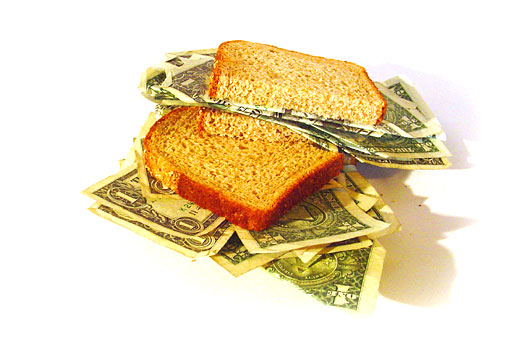
President-elect Barack Obama and the new Congress can’t afford to turn their attention to reforming the food system.
We’ve got two wars to fight, the Middle East conflict is raging again, the financial system is in chaos, and layoffs are mounting. And don’t forget the likelihood of trillion-dollar annual budget deficits for years to come. Food, it’s clear, is just too banal when matched up against those challenges.
That’s the conventional wisdom, anyway.
Even some veteran food-reform advocates accept the “food-must-wait” logic. “I think it’s somewhere between naïve and fairy tale to think [Obama’s] No. 1 focus is going to be on food,” Ann Cooper recently told The New York Times. Cooper is the “renegade lunch lady” who’s made a mission of turning public-school cafeterias into places where people actually cook nutritious food. When someone as bold as she preaches patience, it’s time to sit up and take note.
But while food can’t be the nation’s No. 1 priority, we can no longer afford to keep it on the back burner, either. As Michael Pollan made clear in his widely read open letter to the next president last fall, our food system contributes mightily to problems that have been bedeviling our society for decades and show no sign of letting up: dependence on greenhouse gas-spewing petroleum, violent entanglements in the regions where that resource is concentrated, and a flailing, unjust health care system.
Pollan deftly defined the food system as a prime leverage point. Reform it, he argued, and you create opportunities to really treat these on-the-verge-of-metastasizing maladies. Ignore it, he warned, and we lurch ever closer to climate and public-health catastrophes.
Spice Up the Stimulus Package
So the conventional wisdom is wrong; food-system reform can’t wait. But how do we elevate it on the national agenda when the political class is focused on other things? I have an idea that wouldn’t require a radically new program or a major expenditure of political capital.
Obama has already argued that a comprehensive “stimulus package” — a mammoth government expenditure, fiscal deficit be damned — is necessary to revive the economy as it stumbles into the worst recession in at least a generation. The president-elect reckons that the package — a combination of new spending and tax cuts — will cost between $775 million and $1.2 trillion.
This represents a stunningly large claim on the nation’s resources. The new administration and Congress are obligated to spend it in ways that don’t just create immediate jobs, but that also generate positive ripple effects for decades to come. At this point, the great bulk of expenditures seems destined to flow toward repairing the nation’s creaking road-and-bridge infrastructure.
But a better use would be to dedicate a large portion of the stimulus to infrastructure that bolsters local and regional food systems. Despite the dramatic recent success of farmers markets, CSAs, and other initiatives, the great bulk of the food consumed in this country is grown in chemical-intensive monocrops, processed until it’s unrecognizable, and hauled vast distances in highway-chewing, greenhouse gas-spewing trucks. As I’ve argued so many times, that’s because our nation has spent decades building a food infrastructure geared to industrial production.
Think Locally, Act Infrastructurally
As the food industry consolidated over the past half century — aided by the federal government through generous subsidies to commodity farmers and lax antitrust enforcement — local and regional-scale slaughterhouses, canneries, and dairy-processing plants were the economic victims. Reviving that infrastructure would significantly lower costs for the sort of pasture-based, sustainable meat farmers who are now badly undercut on price by large-scale, environmentally ruinous producers. The legendary Virginia farmer Joel Salatin of Polyface Farm reckons that having to haul his cows to a distant slaughterhouse adds a dollar a pound to the price of his grass-fed beef. Why not make federal grants to rebuild the missing facilities that sustainable-minded farmers need to thrive?
Here’s another idea: reinvest in school-cafeteria kitchens. Starting in the Reagan era, the federal government stopped funding school kitchen equipment. From that time on, cafeterias had to finance themselves through sales of food. As a result, schools began to turn kitchens into reheating centers for stuff like pre-fab chicken nuggets. Once staffed by trained cooks, cafeterias became the domain of button-pushing clerks. A generation of school children was thus exposed to flavorless, nutritionally empty food.
Let’s use the stimulus package as the occasion for a new, major investment in school kitchens. And to help staff the newly outfitted kitchens and teach the clerks to cook, the government should launch a Teach for America-style program to lure in newly minted cooking school graduates. (After all, new chefs may have trouble finding work at fancy restaurants over the next few years.)
These are just a few ideas for how the stimulus could be used to bolster local and regional food networks. The truth is that any effective effort to do this will vary widely by region and be accompanied by serious on-the-ground consultation with alternative food-system actors across the country.
Obama has so far shown little appetite for taking on the vested interests that control our food, as evidenced by his choice of a corn-belt politician with agribusiness ties to be the next USDA chief. But maybe he needn’t confront those forces directly. As the design innovator Buckminster Fuller wrote, “You never change things by fighting the existing reality. To change something, build a new model that makes the existing model obsolete.”
The stimulus gives the new president and Congress the opportunity to give a decisive boost to ongoing efforts to create a new food system. I hope they take it while it’s hot.
Meanwhile, I’d like to hear Grist readers’ ideas for how the stimulus spending can be used to improve the local food system. Together, maybe we can come up with ideas so good that Washington can’t ignore them. The comments section below awaits your thoughts.

